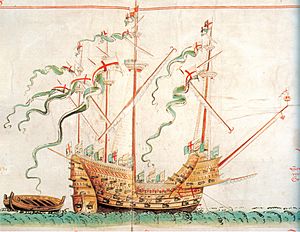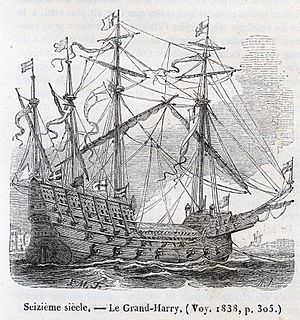Henry Grace à Dieu facts for kids

Henry Grace à Dieu as depicted in the Anthony Roll
|
|
Quick facts for kids History |
|
|---|---|
| Name | Henry Grace à Dieu (from 1547 Edward) |
| Namesake | |
| Builder | Woolwich Dockyard |
| Launched | 13 June 1514 |
| Commissioned | 1514 |
| Refit | Rebuilt circa 1536 |
| Honours and awards |
Battle of the Solent |
| Fate | Accidentally destroyed by fire at Woolwich in August 1553 |
| General characteristics | |
| Tons burthen | 1000 |
| Length | 165 ft (50.29 m) |
| Complement | 700 |
| Armament | 43 cannons, 141 swivel guns |
Henry Grace à Dieu (which means "Henry, Thanks be to God") was a huge English warship from the 1500s. People also called her Great Harry. She was a type of ship called a carrack, known for being very large.
When she was built, Henry Grace à Dieu was the biggest warship in the world! She was even larger than the famous Mary Rose. This amazing ship served as the main ship, or "flagship," for King Henry VIII. She was about 165 feet (50 meters) long and weighed 1,000 tons burthen (a way to measure a ship's size). She could carry a crew of 700 sailors and soldiers. King Henry VIII ordered her to be built, possibly to replace an older ship that had been destroyed in a battle in 1512. At that time, England was competing with Scotland to have the biggest warships. Henry Grace à Dieu was built to be even bigger than Scotland's huge ship, Great Michael.
Building a Giant Ship
The Henry Grace à Dieu was built between 1512 and 1514. She was constructed at a special place called Gun Wharf in Old Woolwich, England. This place later became the famous Woolwich Dockyard, where many ships were built for hundreds of years.
This ship was one of the first to have special openings called gunports. These holes in the side of the ship allowed heavy cannons to fire. She had 20 powerful bronze cannons, which meant she could fire a strong "broadside" (all the guns on one side firing at once). In total, she had 43 large guns and 141 smaller guns!
Ship Problems and Upgrades
When the ship was first built, sailors noticed a problem. She was "top heavy," meaning she wobbled a lot in rough seas. This made it hard for the gunners to aim accurately. To fix this, the ship went through a big repair and upgrade in 1536. This happened in Erith, the same year the Mary Rose was also rebuilt.
During this upgrade, the ship's hull (the main body) was made shorter. After the changes, she still weighed 1,000 tons. She now carried 151 guns of different sizes, including 21 made of bronze. Her crew size was also adjusted to between 700 and 800 people.
The ship also got a new and improved way of sailing. She had four masts, each divided into three parts. The front two masts had square sails, and the back two had five lateen sails (triangular sails). This design made it easier to handle the sails and helped the ship move faster and turn better. It also made it easier to use her powerful broadside cannons. The only picture we have of the ship from that time is in a book called the Anthony Roll.
Life of the Great Harry
Even though she was a huge warship, Henry Grace à Dieu didn't see much fighting. She was present at the Battle of the Solent in 1545, where the Mary Rose sadly sank.
Mostly, the Henry Grace à Dieu was used for important diplomatic events. For example, she carried King Henry VIII to a meeting with the King of France, Francis I, in 1520. This famous meeting was called the Field of the Cloth of Gold. However, the harbors at Dover and Calais weren't deep enough for such a big ship, so smaller boats had to take the King to and from the Henry Grace à Dieu.
After King Henry VIII died, his son Edward VI became king in 1547. The ship was then renamed Edward in his honor. Sadly, the Henry Grace à Dieu (now Edward) was accidentally destroyed by a fire in Woolwich in August 1553.
See also
- Henry V's Grace Dieu (1418)
- São João Baptista (galleon)
Sources
- Lincoln P. Paine (1997) Ships of the World: An Historical Encyclopedia Houghton Mifflin ISBN: 0-85177-739-2


